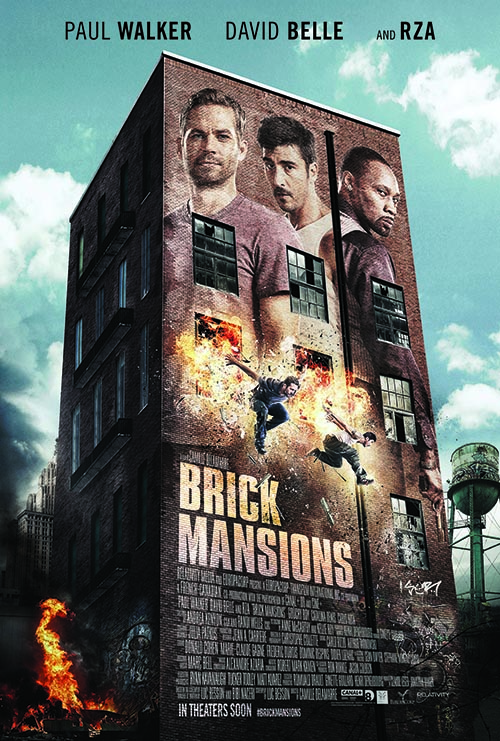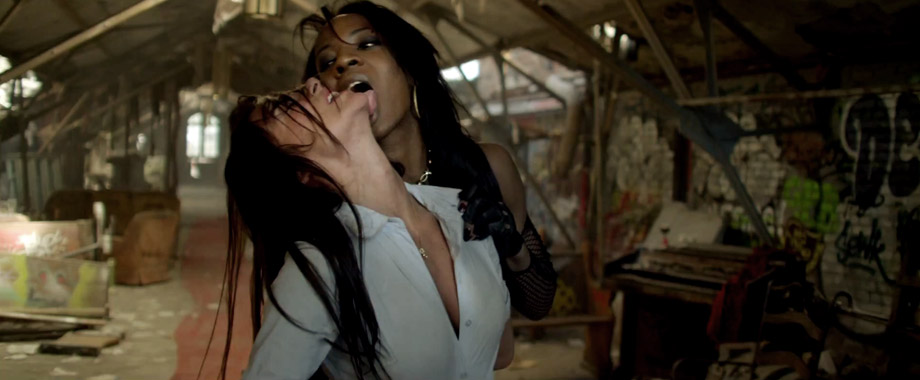 Hey, Luc Besson! John Carpenter called from the eighties and he wants his story back. Besson's latest film, BRICK MANSIONS, redefines the redux. Not only did he poach the original script, he remade it for Hollywood. BRICK MANSIONS is set in another dystopian near future (dystopias are disturbingly fashionable in film today). Crime in Detroit has spiraled out of control, so the government builds a wall around it to segregate the crime-infested ghetto from the rest of society. Then a WMD winds up within the wall in the hands of a terrorist crime lord, and it takes a hero with special skills to save the day. Anyone who has seen Carpenter's campy cult classic, ESCAPE FROM NEW YORK (1981), will recognize this tale. That film was a departure for both director Carpenter, who had built his reputation in horror with HALLOWEEN (1978), and lead actor Kurt Russell, previously known for roles in live-action Disney flicks like THE COMPUTER WORE TENNIS SHOES (1969) and THE STRONGEST MAN IN THE WORLD (1972). Kung Fu film fans will recall another timeless Carpenter and Russell cult classic, BIG TROUBLE IN LITTLE CHINA (1986). But back to BRICK MANSIONS, it has exactly the same plot as ESCAPE FROM NEW YORK but adds one major twist - a major aerial twist off a high-rise without the use of wires.
Hey, Luc Besson! John Carpenter called from the eighties and he wants his story back. Besson's latest film, BRICK MANSIONS, redefines the redux. Not only did he poach the original script, he remade it for Hollywood. BRICK MANSIONS is set in another dystopian near future (dystopias are disturbingly fashionable in film today). Crime in Detroit has spiraled out of control, so the government builds a wall around it to segregate the crime-infested ghetto from the rest of society. Then a WMD winds up within the wall in the hands of a terrorist crime lord, and it takes a hero with special skills to save the day. Anyone who has seen Carpenter's campy cult classic, ESCAPE FROM NEW YORK (1981), will recognize this tale. That film was a departure for both director Carpenter, who had built his reputation in horror with HALLOWEEN (1978), and lead actor Kurt Russell, previously known for roles in live-action Disney flicks like THE COMPUTER WORE TENNIS SHOES (1969) and THE STRONGEST MAN IN THE WORLD (1972). Kung Fu film fans will recall another timeless Carpenter and Russell cult classic, BIG TROUBLE IN LITTLE CHINA (1986). But back to BRICK MANSIONS, it has exactly the same plot as ESCAPE FROM NEW YORK but adds one major twist - a major aerial twist off a high-rise without the use of wires.
Besson's plot-poaching is actually a decade old already. BRICK MANSIONS is a remake of Besson's 2004 screenplay, Banlieue 13. Banlieue 13 (2004) - or as it was known for its 2006 U.S. theatrical release,
DISTRICT B13 - was a landmark martial arts movie because it showcased a new style on the silver screen, the unique French-born method called Parkour. The lead in both BRICK MANSIONS and DISTRICT B13 is David Belle, the man credited as the founder of Parkour.
Parkour emerged in the late eighties. Dubbed the "art of movement," it entails overcoming obstacles in an efficient, flowing manner, often highly acrobatic, typically in an urban environment. Early in its development, it was compared to the lithe evasions of Jackie Chan. But Parkour exponents claim that it actually descended from a French military training method that uses obstacle courses. "Parcours du combatant" was developed by a renowned French physical theorist named Georges Hébert (1875-1957) who propounded a program of exercise he called Méthode naturelle. His personal motto was, "Être fort pour être utile ('Being strong to be useful')." The word "parcours" can mean journey, route, trip or course. It is the same root word from which we get parcourse. A parcourse is a fitness trail that gained popularity in the early seventies and can now be found in parks and public areas all around the world. Many Americans mistakenly believe that these are called "par courses" because participants are challenged to score a "par" number of repetitions with each exercise station, but it actually descended from Hébert's Parcours du combatant. Belle learned the phrase from his father, Raymond Belle, a French veteran and military firefighter who was born in Vietnam when it was still a colony of France. Raymond Belle was a major advocate of Hébert's Méthode naturelle and inspired his son David, along with David's childhood friend Sébastien Foucan (Foucan is best known for his stunt work in CASINO ROYALE (2006) and has since created a splinter style he calls "freerunning"). Barring comparisons to Jackie Chan, Parkour is a great style for movie stunt work, and David Belle now has over a dozen film credits to his name. In PRINCE OF PERSIA: THE SANDS OF TIME (2010), Belle was even credited as "Parkour Choreographer."
DISTRICT B13 was the first film to really showcase Parkour, which for fans of the genre was far more pivotal than Carpenter and Russell breaking their stereotypes. David Belle played Leïto, a native of District B13 with a heart of gold working to undermine the oppressive crime lords. In a cliché buddy-flick plot device, Leïto is coupled with an undercover cop named Captain Damien Tomaso. Tomaso was played by Cyril Raffaelli, an exponent of Modern Wushu and Shotokan Karate. Raffaelli had worked with Besson before, most notably as a stuntman on THE TRANSPORTER (2002) and as Twin in Besson's collaboration with Jet Li KISS OF THE DRAGON (2001). He also appeared as a henchman in Bruce Willis's LIVE FREE OR DIE HARD (2007).
BRICK MANSIONS versus DISTRICT B13
In BRICK MANSIONS, Belle plays the exact same role, although renamed Lino Dupree. Taking over for Raffaelli is Paul Walker in one of his final film performances after his tragic death in November of last year. Most recognized for his recurring role as Brian O'Connor in the FAST & FURIOUS franchise (2001-2013), he died while FAST & FURIOUS 7 was in production. With that film scheduled for release in 2015, BRICK MANSIONS may not be his final film appearance. Walker plays the undercover cop Damien Collier, and though lacking the extensive martial background of Raffaelli, he was a practitioner of Jiu-Jitsu and was awarded an honoraryblack belt by his instructor in memoriam.
Filling out the cast is the one and only RZA. After his disappointing personal project, THE MAN WITH THE IRON FISTS (2012) (to which there is a very subtle nod in BRICK MANSIONS), RZA has taken on additional martially-influenced roles such as the blind Abbot in G. I. JOE: RETALIATION (2013) and the top villain in Tony Jaa's THE PROTECTOR 2 (2013). Alongside the premiere of BRICK MANSIONS, RZA managed to get even more viral buzz going about Wu-Tang Clan's unprecedented single-copy album, Once Upon a Time in Shaolin. The preeminent rap group will only cut one edition of this album and tour it around the country like a museum-quality piece of art. At this writing, RZA already claims a $5 million offer for it.
The bulk of BRICK MANSIONS is exactly like DISTRICT B13, in many instances scene-for-scene, but Walker and RZA bring some new dimensions to the film. Walker's down-to-earth charisma still shines, perhaps even more so given his untimely death. His comic timing is perfect for an action star, and it's hard to watch him act and not ponder what could have been. RZA has found a new calling in playing villains. He brings a disturbing authenticity as an original gangsta. Oddly, his character Tremaine is supposed to be Jamaican, cooking curry goat with a huge poster of Bob Marley in his lair, and constantly dropping Marley lyrics. It's odd because RZA's vocal talents aren't within a Jamaican patois, but instead within his Staten/Shaolin rap, as no one can drop the N-word as lyrically as RZA.

There are a few other minor changes from the original. The character of Lola, played by Catalina Denis in BRICK MANSIONS, is now Lino's girlfriend. In DISTRICT B13, Lola was played by Dany-Verissimo-Petit and was Leïto's sister. Lola is far more hardcore in the original and suffers a horrible fate that is deleted from the U.S. version. However, BRICK MANSIONS adds a new villainess for contrast. Rayzah, played by Ayisha Issa, is a kinky assassin clad in dominatrix attire, perfect for some exploitive cat fights against Lola. Issa steals many of the scenes from her more veteran costars. Born in Ghana of Jamaican parents, Issa had her first major role in IMMORTALS (2011). More notably, she currently holds a blue belt in Brazilian Jiu-Jitsu and has competed internationally in the Pan Americans (2014) and the Worlds (2010). She is a stunning beauty and in peak physical shape, an unexpected treasure in BRICK MANSIONS with potential to be a future martial starlet.
However, beyond cat fights, Jiu-Jitsu has yet to display the choreographic suspense needed for film. Walker was fit, well equipped to throw down in a fight scene, but pales in comparison to the precision of Raffaelli. In the sequel, DISTRICT B13: ULTIMATUM (2009), Raffaelli delivered a complex opening fight sequence worthy of Jackie Chan, a frantic melee against gangsters while trying to protect a Van Gogh painting - while in drag, no less. Walker's fight scenes are good for a standard action flick, and much is redeemed with some frenetic camerawork, but he's not nearly on par for a good martial arts film. Belle is the real martial arts star here. Ten years later, at age forty-one, Belle still has the moves. His Parkour remains spectacular to watch. His stunts are not quite as over-the-top as in DISTRICT B13; for his two biggest jumps in BRICK MANSIONS, the first is tampered with by a CGI-grenade explosion (Parkour with CGI or wires simply is not Parkour) and the second isn't captured in one continuous shot, so it's difficult to tell whether it was real. Towards the latter part of the film, Belle's fight choreography almost feels dumbed down so Walker can keep up. Nevertheless, especially in the beginning of the film, Belle brings his signature Parkour choreography, and that's a beauty to behold.

As a remake, BRICK MANSIONS is reminiscent of another Luc Besson screenplay, LA FEMME NIKITA (1990) starring Anne Parillaud. That film was the grandmother of the sexy young assassin spy heroine and spawned numerous remakes including a Hollywood version, Bridget Fonda's POINT OF NO RETURN (1993), a Hong Kong version, Jade Leung's BLACK CAT (1991), and two TV series: LA FEMME NIKITA (1997-2001) starring Peta Wilson (which ran for five seasons on USA Network) and NIKITA, starring Maggie Q (2010-present). All of those remakes were entertaining for different reasons, and a fan might be hard-pressed to say which version was best. Besson's basic plot concept for Nikita was brilliant and clearly stood the test of time.
BRICK MANSIONS may not have quite the resiliency. With its original plot poached from Carpenter, it was really more of a vehicle for Parkour than an innovation in storyline. Coupled with Walker's untimely death, BRICK MANSIONS is well positioned for its premiere and is still a fine showcase for Parkour. And who knows? Maybe it could become a TV series in the future. Now that Parkour has established itself internationally, there are plenty of young enthusiasts poised to inherit Belle's mantle. Like with BLACK CAT, it would be very intriguing if a Chinese version emerged.
![]() Print Friendly Version of This Article
Print Friendly Version of This Article
















